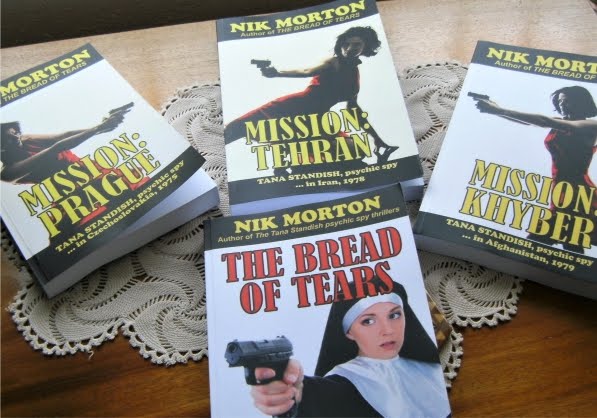Even if you only have a passing interest in the Bond canon, publicity should have alerted you to the fact that Horowitz has set the story in 1957, a couple of weeks after Goldfinger, and at the beginning of the book he’s entertaining Pussy Galore in his London flat. Then he gets the summons from M – the Soviets are intent on sabotaging the British contender in a Grand Prix motor race in Germany. In the process of countering this threat, Bond stumbles upon an intriguing connection between Soviet general Gaspanov and a Korean millionaire, Sin Jai-Seong. That association sets alarm bells ringing and he decides to investigate.
All
of the trademark ingredients are assembled – seamlessly: Sin, an
unprepossessing villain, Jeopardy Lane, an ‘ugly-pretty’ female, an enemy
lair to infiltrate, hairs-breadth escapes, the following of slim clues to the
puzzle, the inevitable capture, a lengthy exposition by the villain, the
fiendish choice of death allotted to Bond, and the ‘ticking-bomb’ final act.
Horowitz
wanted to reference the earlier books rather than the films, obviously, and
succeeds, even to the point of having his characters provide unbroken speech
for a page or more, in the manner of Fleming. The settings are perhaps not as
exotic, but hold the interest nevertheless: the Grand Prix racetrack, the
American rocket launch site, and the subway system of New York.
Both
in tone and manner, Bond seems right. I’d be intrigued to know what was excised
from the early drafts, however. In one interview Horowitz says that his wife
(Jill Green, producer of Foyle’s War) suggested considerable rewriting. She
felt that some of the sexism in the book was ‘a little too extreme’. These days
there must be a danger of writing a politically correct Bond, which honestly
would emasculate the character. I think Horowitz trod this line carefully and
pulls it off for his late 1950s characters.
Initially,
it seems highly implausible, the idea that Bond – a secret agent with a licence
to kill – would be given the mission to learn how to drive a racing car in preparation
for a prestigious event, and use that car to thwart the Soviet driver’s
murderous plans. (Who said Bond stories had to be plausible, anyway?) Surely,
all Bond had to do was accidentally trip the fellow on the stairs, break a leg
or two – or if the Soviet racer was a really bad egg, kill him? However, as the
400-500 words of original Fleming text that triggered the storyline (‘Murder on
Wheels’) [no pun intended] was about Bond and ‘top-class motor racing’,
Horowitz must have felt compelled to wear that particular strait-jacket for
this outing. Once the race is over, he gives free rein to his imagination and
the pace quickens considerably. And indeed some of Fleming’s Bond adventures began
with very little real spying, yet 007’s inquisitive mind often latched onto
something sinister that led to adventure, travel, sex and near-death
experiences.
The
references to earlier Bond adventures – Dr
No and Moonraker – are subtle, not
even being named but alluded to at appropriate moments.
There
are three so-called Bond girls: Pussy Galore, Logan Fairfax, and Jeopardy Lane,
and all of them are strong women, capable of looking after themselves. Logan is
Bond’s instructor at the English racetrack prior to him going to Germany. Jeopardy’s
back-story was interesting (delivered in a page of uninterrupted speech) and
she had the potential to go further in another adventure.
A
handful of reviewers have criticised Horowitz regarding some inaccuracies. And
that’s despite the time and effort he clearly spent in research. (Oh, writing
is a thankless task, writing make-believe to appear ‘real’ and being castigated
when it isn’t quite real enough!) No matter how strenuous the research, we get
things ‘wrong’ somewhere along the line. Having said that, as a reader I rarely
let a few minor hiccups blight the story for me – and even if I spotted at
least one flaw, it didn’t spoil this fast-paced adventure.
There
is a reason for the pun-style title, too. The ending of Trigger Mortis is excellent, by the way. I – and doubtless many
other readers – would be pleased to read another Bond adventure from Anthony
Horowitz.
The flaw
Despite
being a respected journalist, Fleming didn’t always concern himself with
accuracy (ask ‘Major’ Geoffrey Boothroyd about that!) so it comes as no
surprise that he was using the Soviet organ of assassination SMERSH in his Bond
novels up to 1957, although in 1946 it was absorbed into the MGB, the
forerunner of the KGB. At that point, Department V of the First Directorate of
the KGB took upon itself the assassination role. Perhaps Department V didn’t
sound as sinister as ‘Death to Spies’?

























No comments:
Post a Comment